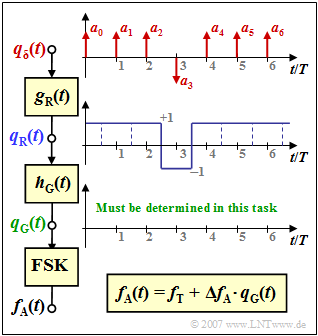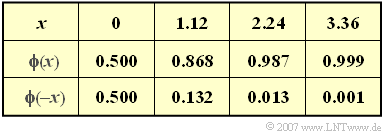Difference between revisions of "Aufgaben:Exercise 3.5: GMSK Modulation"
| Line 3: | Line 3: | ||
}} | }} | ||
| − | [[File:EN_Mob_A_3_5.png|right|frame| | + | [[File:EN_Mob_A_3_5.png|right|frame|different signals of GMSK-Modulation]] |
The modulation method used for GSM is ''Gaussian Minimum Shift Keying'', short GMSK. This is a special type of FSK (''Frequency Shift Keying'') with CP-FSK (''Continuous Phase Matching''), where | The modulation method used for GSM is ''Gaussian Minimum Shift Keying'', short GMSK. This is a special type of FSK (''Frequency Shift Keying'') with CP-FSK (''Continuous Phase Matching''), where | ||
Revision as of 09:06, 30 June 2020
The modulation method used for GSM is Gaussian Minimum Shift Keying, short GMSK. This is a special type of FSK (Frequency Shift Keying) with CP-FSK (Continuous Phase Matching), where
- the modulation index has the smallest value that just satisfies the orthogonality condition: $h = 0.5$ ⇒ Minimum Shift Keying,
- a Gaussian low pass with the impulse response $h_{\rm G}(t)$ is inserted before the FSK modulator, with the aim of saving even more bandwidth.
The graphic illustrates the situation:
- The digital message is represented by the amplitude coefficients $a_{\mu} ∈ \{±1\}$ which are applied to a Dirac pulse. It should be noted that the sequence drawn in is assumed for the subtask (3).
- The symmetrical rectangular pulse with duration $T = T_{\rm B}$ (GSM bit duration) is dimensionless:
- $$g_{\rm R}(t) = \left\{ \begin{array}{c} 1 \\ 0 \\ \end{array} \right.\quad \begin{array}{*{5}c} {\rm{{\rm{f\ddot{u}r}}}} \\ {\rm{{\rm{f\ddot{u}r}}}} \\ \end{array}\begin{array}{*{5}c} |\hspace{0.05cm} t \hspace{0.05cm}| < T/2 \hspace{0.05cm}, \\ |\hspace{0.05cm} t \hspace{0.05cm}| > T/2 \hspace{0.05cm}. \\ \end{array}$$
- This results for the rectangular signal
- $$q_{\rm R} (t) = q_{\rm \delta} (t) \star g_{\rm R}(t) = \sum_{\nu} a_{\nu}\cdot g_{\rm R}(t - \nu \cdot T)\hspace{0.05cm}.$$
- The Gaussian low pass is given by its frequency response or impulse response:
- $$H_{\rm G}(f) = {\rm e}^{-\pi\cdot (\frac{f}{2 f_{\rm G}})^2} \hspace{0.2cm}\bullet\!\!-\!\!\!-\!\!\!-\!\!\circ\, \hspace{0.2cm} h_{\rm G}(t) = 2 f_{\rm G} \cdot {\rm e}^{-\pi\cdot (2 f_{\rm G}\cdot t)^2}\hspace{0.05cm},$$
- where the system theoretical cut-off frequency $f_{\rm G}$ is used. In the GSM specification, however, the 3dB cut-off frequency is specified with $f_{\rm 3dB} = 0.3/T$ . From this, $f_{\rm G}$ can be calculated directly - see subtask (2).
- The signal after the gauss low pass is thus
- $$q_{\rm G} (t) = q_{\rm R} (t) \star h_{\rm G}(t) = \sum_{\nu} a_{\nu}\cdot g(t - \nu \cdot T)\hspace{0.05cm}.$$
Here $g(t)$ is referred to as frequency pulse. For this one:
- $$g(t) = q_{\rm R} (t) \star h_{\rm G}(t) \hspace{0.05cm}.$$
- With the low pass filtered signal $q_{\rm G}(t)$, the carrier frequency $f_{\rm T}$ and the frequency deviation $\Delta f_{\rm A}$ can thus be written for the instantaneous frequency at the output of the FSK modulator::$$f_{\rm A}(t) = f_{\rm T} + \Delta f_{\rm A} \cdot q_{\rm G} (t)\hspace{0.05cm}.$$
Notes:
- This exercise belongs to the chapter Die Charakteristika von GSM.
- Reference is also made to the chapter Funkschnittstelle in the book „Beispiele von Nachrichtensystemen”.
- For your calculations use the exemplary values $f_{\rm T} = 900 \ \ \rm MHz$ and $\Delta f_{\rm A} = 68 \ \rm kHz$.
- Use the Gaussian integral to solve the task (some numerical values are given in the table)
- $$\phi(x) =\frac {1}{\sqrt{2 \pi}} \cdot \int^{x} _{-\infty} {\rm e}^{-u^2/2}\,{\rm d}u \hspace{0.05cm}.$$
Questionnaire
Sample solution
(1) If all amplitude coefficients $a_{\mu}$ are equal to $+1$, then $q_{\rm R}(t) = 1$ is a constant. Thus, the Gaussian low pass has no influence and $q_{\rm G}(t) = 1$ results.
- The maximum frequency is thus
- $${\rm Max}\ [f_{\rm A}(t)] = f_{\rm T} + \Delta f_{\rm A} \hspace{0.15cm} \underline {= 900.068\,{\rm MHz}} \hspace{0.05cm}.$$
- The minimum instantaneous frequency
- $${\rm Min}\ [f_{\rm A}(t)] = f_{\rm T} - \Delta f_{\rm A} \hspace{0.15cm} \underline { = 899.932\,{\rm MHz}} \hspace{0.05cm}$$
is obtained when all amplitude coefficients are negative. In this case $q_{\rm R}(t) = q_{\rm G}(t) = -1$.
(2) The frequency at which the logarithmic power transfer function is $3 \ \rm dB$ less than $f = 0$ is called the 3dB cut-off frequency.
- This can also be expressed as follows:
- $$\frac {|H(f = f_{\rm 3dB})|}{|H(f = 0)|}= \frac{1}{\sqrt{2}} \hspace{0.05cm}.$$
- In particular the Gauss low pass because of $H(f = 0) = 1$:
- $$ H(f = f_{\rm 3dB})= {\rm e}^{-\pi\cdot ({f_{\rm 3dB}}/{2 f_{\rm G}})^2} = \frac{1}{\sqrt{2}}\hspace{0.3cm} \Rightarrow \hspace{0.3cm}(\frac{f_{\rm 3dB}}{2 f_{\rm G}})^2 = \frac{{\rm ln}\hspace{0.1cm}\sqrt{2}}{\pi} \hspace{0.3cm}\Rightarrow \hspace{0.3cm}f_{\rm G} = \sqrt{\frac{\pi}{4 \cdot {\rm ln}\hspace{0.1cm}\sqrt{2}}}\cdot f_{\rm 3dB}\hspace{0.05cm}.$$
- The numerical evaluation leads to $f_{\rm G} \approx 1.5 \cdot f_{\rm 3dB}$.
- From $f_{\rm 3dB} \cdot T = 0.3$ follows $f_{\rm G} \cdot T \underline{\approx 0.45}$.
(3) The frequency pulse ${\rm g}(t)$ results from the convolution of the rectangular function $g_{\rm R}(t)$ with the pulse response $h_{\rm G}(t)$:
- $$g(t) = g_{\rm R} (t) \star h_{\rm G}(t) = 2 f_{\rm G} \cdot \int^{t + T/2} _{t - T/2} {\rm e}^{-\pi\cdot (2 f_{\rm G}\cdot \tau)^2}\,{\rm d}\tau \hspace{0.05cm}.$$
- With the substitution $u^{2} = 8π \cdot {f_{G}}^{2} \cdot \tau^{2}$ and the function $\phi (x)$ you can also write for this:
- $$g(t) = \ \frac {1}{\sqrt{2 \pi}} \cdot \int^{2 \cdot \sqrt{2 \pi} \cdot f_{\rm G} \cdot(t + T/2)} _{2 \cdot \sqrt{2 \pi} \cdot f_{\rm G} \cdot(t - T/2)} {\rm e}^{-u^2/2}\,{\rm d}u = \ \phi(2 \cdot \sqrt{2 \pi} \cdot f_{\rm G} \cdot(t + T/2))- \phi(2 \cdot \sqrt{2 \pi} \cdot f_{\rm G} \cdot(t - T/2)) \hspace{0.05cm}.$$
- For the time $t = 0$ is valid considering $\phi (-x) = 1 - \phi (x)$ and $f_{\rm G} \cdot T = $0.45
- $$g(t = 0) = \ \phi(\sqrt{2 \pi} \cdot f_{\rm G} \cdot T)- \phi(-\sqrt{2 \pi} \cdot f_{\rm G} \cdot T)= \ 2 \cdot \phi(\sqrt{2 \pi} \cdot f_{\rm G} \cdot T)-1 \approx 2 \cdot \phi(1.12)-1 \hspace{0.15cm} \underline {= 0.737} \hspace{0.05cm}.$$
(4) With $a_{3} = +1$ the result would be $q_{\rm G}(t = 3 T) = 1$. Due to the linearity, the following therefore applies:
- $$q_{\rm G}(t = 3 T ) = 1 - 2 \cdot g(t = 0)= 1 - 2 \cdot 0.737 \hspace{0.15cm} \underline {= -0.474} \hspace{0.05cm}.$$
(5) With the result of (3) and $f_{\rm G} \cdot T = $0.45 you get
- $$g(t = T) = \ \phi(3 \cdot \sqrt{2 \pi} \cdot f_{\rm G} \cdot T)- \phi(\sqrt{2 \pi} \cdot f_{\rm G} \cdot T) \approx \phi(3.36)-\phi(1.12) = 0.999 - 0.868 \hspace{0.15cm} \underline { = 0.131} \hspace{0.05cm}.$$
- The pulse value $g(t = -T)$ is exactly the same due to the symmetry of the Gaussian low pass.
(6) With alternating sequence, the absolute values $|q_{\rm G}(\mu \cdot T)|$ are all the same for all multiples of the bit duration $T$ for reasons of symmetry.
- All intermediate values at $t \approx \mu \cdot T$ are smaller.
- Taking $g(t ≥ 2T) \approx 0$ into account, each individual pulse value $g(0)$ is reduced by the preceding pulse with $g(t = T)$, and also by the following pulse with $g(t = -T)$.
- So there will be impulse interference and you get
- $${\rm Max} \hspace{0.12cm}[q_{\rm G}(t)] = g(t = 0) - 2 \cdot g(t = T) = 0.737 - 2 \cdot 0.131 \hspace{0.15cm} \underline {= 0.475 }\hspace{0.05cm}.$$

